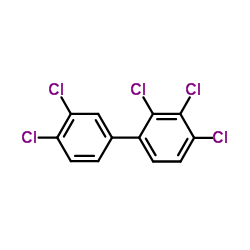PCB No 157(Aroclor 1254) solution

PCB No 157(Aroclor 1254) solution structure
|
Common Name | PCB No 157(Aroclor 1254) solution | ||
|---|---|---|---|---|
| CAS Number | 11097-69-1 | Molecular Weight | 326.433 | |
| Density | 1.5±0.1 g/cm3 | Boiling Point | 392.2±37.0 °C at 760 mmHg | |
| Molecular Formula | C12H5Cl5 | Melting Point | 95.86°C (estimate) | |
| MSDS | Chinese USA | Flash Point | 193.6±23.9 °C | |
| Symbol |




GHS02, GHS07, GHS08, GHS09 |
Signal Word | Danger | |
Use of PCB No 157(Aroclor 1254) solutionArochlor 1254 is a polychlorinated biphenyl (PCB) mixture with biphenyl and 54% chlorine. Aroclor 1254 reduced cell viability and induced overproduction of intracellular reactive oxygen species in a dose-dependent manner. Arochlor 1254 exposure reduces calcium homeostasis, osteoblast differentiation and bone formation[1]. |
| Name | Aroclor 1254 |
|---|---|
| Synonym | More Synonyms |
| Description | Arochlor 1254 is a polychlorinated biphenyl (PCB) mixture with biphenyl and 54% chlorine. Aroclor 1254 reduced cell viability and induced overproduction of intracellular reactive oxygen species in a dose-dependent manner. Arochlor 1254 exposure reduces calcium homeostasis, osteoblast differentiation and bone formation[1]. |
|---|---|
| Related Catalog | |
| References |
| Density | 1.5±0.1 g/cm3 |
|---|---|
| Boiling Point | 392.2±37.0 °C at 760 mmHg |
| Melting Point | 95.86°C (estimate) |
| Molecular Formula | C12H5Cl5 |
| Molecular Weight | 326.433 |
| Flash Point | 193.6±23.9 °C |
| Exact Mass | 323.883392 |
| LogP | 6.36 |
| Vapour Pressure | 0.0±0.9 mmHg at 25°C |
| Index of Refraction | 1.620 |
| Storage condition | room temp |
| Stability | Stable. Highly flammable. Incompatible with strong oxidizing agents. Attacks some forms of plastics and rubber. |
| Symbol |




GHS02, GHS07, GHS08, GHS09 |
|---|---|
| Signal Word | Danger |
| Hazard Statements | H225-H304-H315-H336-H373-H410 |
| Precautionary Statements | P210-P273-P301 + P310-P331-P370 + P378-P501 |
| Personal Protective Equipment | Eyeshields;Faceshields;full-face respirator (US);Gloves;multi-purpose combination respirator cartridge (US);type ABEK (EN14387) respirator filter |
| Hazard Codes | F,Xn,N,T |
| Risk Phrases | 11-38-50/53-65-67-33-62-51/53-48/20-36/37/38-22-39/23/24/25-23/24/25-40-37/38-20/21/22-45 |
| Safety Phrases | 9-16-29-33-60-61-62-35-36/37-36-26-45-7-23-53 |
| RIDADR | 2315 |
| RTECS | TQ1360000 |
| Packaging Group | II |
|
A novel toxicogenomics-based approach to categorize (non-)genotoxic carcinogens.
Arch. Toxicol. 89 , 2413-27, (2015) Alternative methods to detect non-genotoxic carcinogens are urgently needed, as this class of carcinogens goes undetected in the current testing strategy for carcinogenicity under REACH. A complicatin... |
|
|
Enormous PCBs increase in oysters from the coast of Guangdong, China
Mar. Pollut. Bull. 62(6) , 1333-6, (2011) Highlights ► PCB concentrations (ngg−1 d.w.) ranged from 30 to 2040 with a mean of 315 in 2003–2007. ► Annual PCB levels were 313, 290, 342ngg−1 d.w., respectively in 2003, 2006, 2007. ► Recent PCB le... |
|
|
Transcriptome-wide gene expression in a rat model of attention deficit hyperactivity disorder symptoms: rats developmentally exposed to polychlorinated biphenyls.
Am. J. Med. Genet. B. Neuropsychiatr. Genet. 156B(8) , 898-912, (2011) Polychlorinated biphenyls (PCB) exposure in rodents provides a useful model for the symptoms of Attention deficit hyperactivity disorder (ADHD). The goal of this study is to identify genes whose expre... |
| 1,1'-Biphenyl, 2,3,3',4,4'-pentachloro- |
| 2,3,3',4,4'-Pentachloro-1,1'-biphenyl |
| 2,3,3',4,4'-Pentachlorobiphenyl |